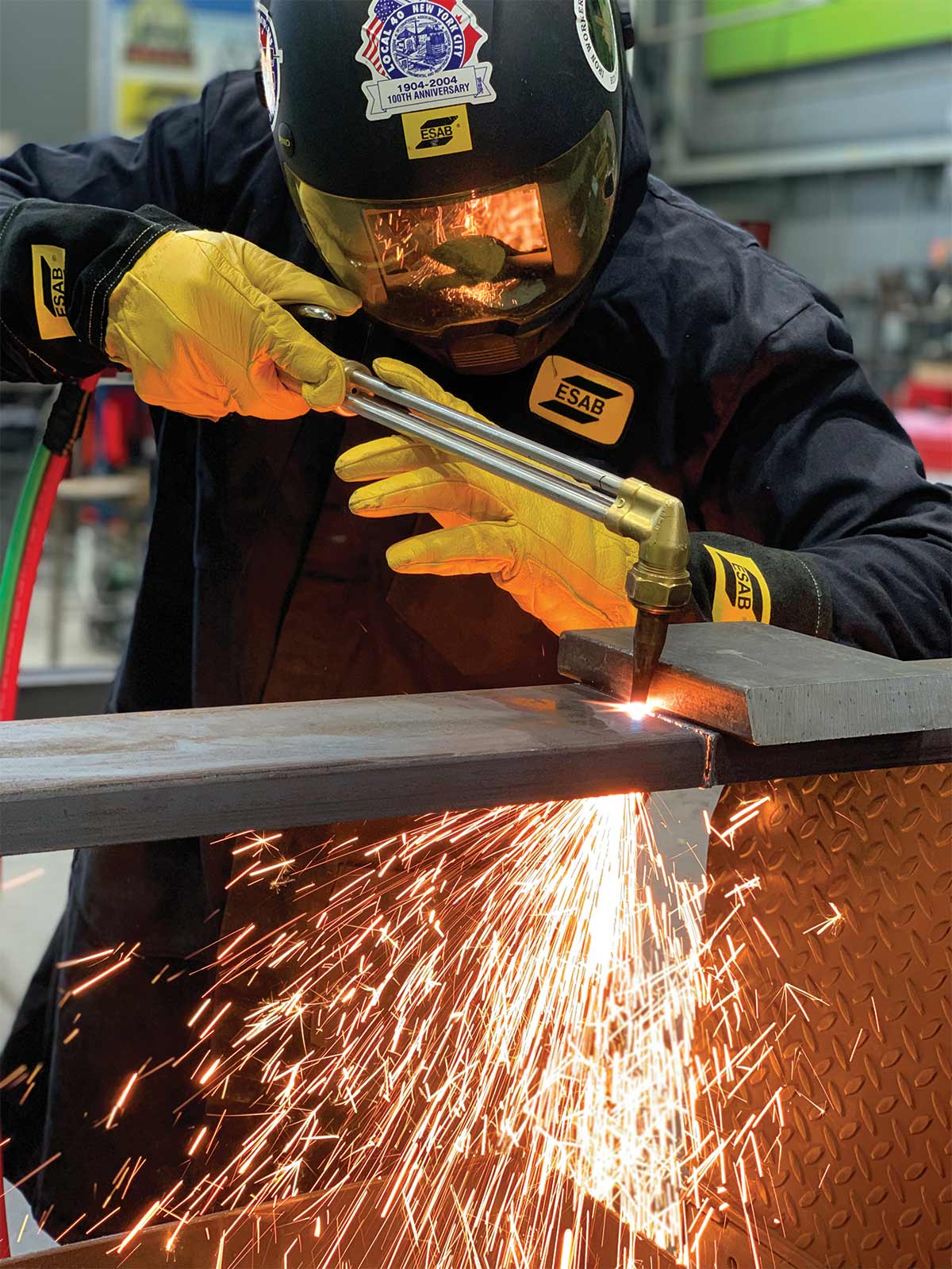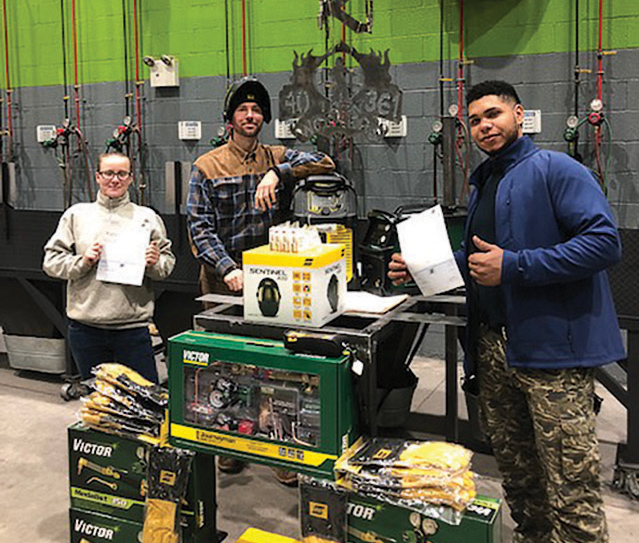ompetition can build character, influence passion, empower careers and affect daily lives, especially when combined with oxy-fuel processes—cutting, heating, welding and brazing. The 2019 Rulers of the Flame contest, sponsored by Victor, an ESAB brand, offered students the opportunity to shape their own characters by working with oxy-fuel equipment.
The competition was open to students enrolled in a welding instructional program at a secondary, post-secondary, technical or vocational school. Winners from three fabrication teams, as well as three individual essay winners, each took home a $250 cash prize and Victor Medalist 350 outfit, while each school received a cutting and welding package valued at more than $8,400.
ESAB’s leaders believe such partnerships between schools and industry are critical to promoting technical education and careers. The Rulers of the Flame contest encourages students to learn technologies and acquire skills that lead to good careers, as well as fostering a sense of pride for performing a job well.
Winning team fabrication projects included a “Stairway to Success,” inspired by artist M.C. Escher’s famous stairway lithograph, created by Iron Workers Locals 40 & 361 Training Center, Astoria, New York; “King of the Mountain,” named for an off-road truck climbing an I-beam mountain, from Rockland BOCES, a technical high school in West Nyack, New York; and “The Fire Pit,” an elaborate hexagonal show of flames from Ogden-Weber Technical College, Ogden, Utah.
Participating students and their instructors had a variety of reasons for entering the competition.
“Many students don’t really know what ironworkers are,” says Iron Workers instructor Conrad Lazare. “Contests such as this help connect us with the community.”
On this project, apprentices took on different roles to learn new skills and put them to good use. “I was able to get more experience with a torch than I’ve ever had,” says apprentice Anastasiya Grishkevich, who was chosen to design the work. “I had only practiced doing straight cuts. I had never made small, curved cuts like I made around the logo.”
As she led the design process, “I was trying to think of how we could make the stairs look like they were not going in one direction,” says Grishkevich. “I like to design things that require meticulous details.” She credits the contest for broadening her skill set. “I learned more about what I can do on the job.”
“I have another year [of study], so it would be great to get involved in another contest,” adds Sandy Matos, another apprentice. “It was a great way to meet new people and try new things.”
“We came up with the idea together and worked together,” Robert Shields, another Rockland team member, says of the collaboration. “When it came to different torch angles, heating the metal and getting good penetration, if someone had a hard time, we would give someone else a try. We switched off until we got it right.”
Moving the torch evenly, in a circular motion from side to side, was key to achieving good penetration on both sides of the plate. Precise cutting required an accurate torch tilt to avoid slag and stopping.
“Communication was the biggest thing to making this work,” says student Thomas McKenna, who worked on truck details and helped cut some of the I-beams with an oxy-fuel torch. “We needed to communicate how to put every single part together and who was going to do what.”
Himelfarb concurs, “We learned we can build stuff if we work well together.”


Instructor Emily Johnson at Ogden-Weber Technology College rounded up “The Fire Pit” team after she saw a post about the contest on ESAB’s Facebook page.
Her first recruit, Christopher Oakes, wanted the project to literally represent the Rulers of the Flame theme. “Once we decided on a fire pit, I had the idea of making the outside ring of flames. We wanted the flames to be freestanding so it looks like the base of the pit is on fire.”
Oakes took the lead, making the mathematical calculations for the design and then drawing the flame panel. “I found a picture online, printed it off and drew a freehand version on a piece of metal,” says Oakes. “I cut it out and used it as a reference for the other panels.”
For the oxy-fuel welding, before the team welded on the base, it welded a mock-up first to “make sure we had the right filler metal,” he says. This way, they knew what would work best “and we wouldn’t have to mess around and replace metal.”
Oakes asked team member Darby McClelland to assist him with cutting. “I was practicing running straight lines, and I had Darby come assist me,” says Oakes. “She’s an all-around natural.”
“The student contest was only the third time I had used a torch,” says McClelland. “Setting up an oxy-fuel outfit intimidated me at first, but now I think it’s a really cool, steady process.”
Teammate Colby Marker learned about the challenges of oxy-fuel welding. “It’s harder to control heat input compared to TIG welding,” says Marker, adding that he enjoyed the experience. “The teamwork—from initial planning and brainstorming to agreeing on everything—was really cool.”
Iron Workers apprentices can speak to how they might leverage their technical education.
“I started welding in college, where I met a girl who was in the union,” says Grishkevich. “She connected me to a women’s apprenticeship program specifically for Iron Workers in California. I did a second pre-apprenticeship here in New York before I started with the Iron Workers here.”
 Things like contests, equipment and community involvement do so much for supporting the future of welding trades.
Things like contests, equipment and community involvement do so much for supporting the future of welding trades. 
Trade union recruiters may scout non-union personnel who have good skill sets. “Iron Workers get more training, so the skill set per individual is usually higher,” says the instructor, Lazare. “Apprentices get about $150,000 of free training. And you don’t have the debt that people have when they go to college.”
Grishkevich is a third-year apprentice and is making repairs on the Manhattan Bridge. Matros, a second-year apprentice, is working on a Wall Street project.
For Rockland BOCES instructor and 16-year industry veteran Andrew Saweikis, community is key to a quality technical education. “I hear from industry people, ‘We need craftsmanship, not just workers,’” he says. “I instill that need for craftsmanship in my students. I talk with business owners and attend community meetings so I’m able to relay their needs to my students. They need a broader skill set than sticking two plates together. This inspires my students to not only learn more but also to take a great amount of pride in their work.”
Himelfarb’s inspiration is simple: “I can build stuff and fix things myself. I don’t need anyone else to do it.” He looks forward to starting his own welding business.
For Himelfarb, welding is a way to work with his hands and “get lost in the puddle.” Many students learning trades don’t feel at home in a lecture hall. Parents and other welders may inspire students seeking a trade, but other potentially skilled welders may flounder due to a lack of exposure and information about the trades and technical education.
“It’s exciting to see more support for trade schools, especially from welding companies,” says Saweikis. “Things like contests, equipment and community involvement do so much for supporting the future of welding trades.”
Exposure to technical skills totally changed McClelland’s career path. “I was bartending and serving before this, and it was just a really stagnant job,” she says. “My boyfriend was welding on his flatbed truck, and I said, ‘I’ve never welded, but I want to try.’ I laid down some beads, and he was impressed. I applied at Ogden-Weber, and the rest is history. Now I’m an apprentice with the International Brotherhood of Boilermakers.”
Annapolis Junction, Maryland, 800/372-2123,
esabna.com